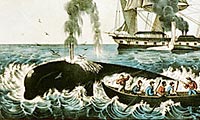
Lesson 1
What I Know/Want to Know About Whaling
- Time Required: 20 minutes (20-30 minute extension optional)
- Curriculum Fits: History
Lesson Overview
This lesson provides an opportunity to activate students' prior knowledge and begin to generate questions that will focus research. Students become involved in an active dialogue about history and whaling and are introduced to the distinction between primary and secondary sources.
Learning Objectives
- Students will demonstrate what they know about whaling prior to extended students.
- Students will formulate questions that will focus research throughout this unit.
- Students will begin a conversation among peers about history and whaling.
- Students will understand the distinction between primary and secondary sources.
- Students will appreciate the biases of surviving historical artifacts.
Materials
- primary source: Currier & Ives lithograph, "Whale Fishery: attacking a right whale", circa 1860
- primary source: transcript of journal article, "Martha's Vineyard - Return of the Whaling Ships" from The Living Age , (May 2,1846)
- board or easel
- large sheets of chart paper or overhead projector
Preparation
Have access to a board, large sheets of easel paper, or overhead projector so that student suggestions can be posted for everyone to see. If you are going to try the extension activity, have copies of the primary sources.
Procedure
- Make a K/W/W/ chart, labeling the columns: "What I Know." "What I Want to Know." "Where I Might Find the Answer." Students can volunteer ideas for a scribe who posts them. Alternatively, students can walk around the room and write their ideas on large sheets of chart paper. A third way to generate ideas would be to ask each student to write their prior knowledge, question and possible historical source on a sheet of paper. This input could then be displayed in chart format.
- Review the chart, keeping in mind that the goal of the activity is to assess student's current level of knowledge about the history of whaling and to encourage questions that pertain to the topic. Most importantly, emphasize that this is a brainstorming activity and that all questions are valid.
- Ask students to consider those sources that might provide a window into the past. Take the opportunity to distinguish primary and secondary source suggestions. Primary sources survive from the time at which events unfolded. Secondary sources have been written since then and try to tell the history. Historians are bound by their sources and this is an excellent opportunity to discuss whose stories are most likely to survive.
- At the end of this lesson or at the beginning of the next lesson, review the chart and highlight those portions of the unit that are likely to answer students' questions.
Assessment
Student's understanding can be assessed through observation during discussion and by looking at the ideas they generate for the K/W/W chart.
Extensions
- Explore Primary Sources - Share two primary sources: Currier & Ives lithograph "Whale Fishery: attacking a right whale", circa 1860 and "Martha's Vineyard - Return of the Whaling Ships," from The Living Age (May 2, 1846). Ask students what they can glean about whaling from these sources. What insights do they provide and what questions do they raise? These primary sources are particularly helpful for students who believe that they know nothing about whaling and could be presented prior to the main lesson.
- Collecting and Collections - Ask an archivist to talk about sources, their preservation, and which types of materials are most common in their collection.
Author
Mary Jane Aldrich-Moodie